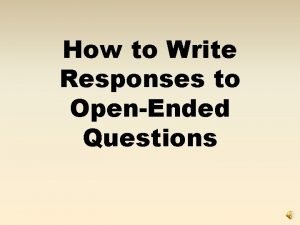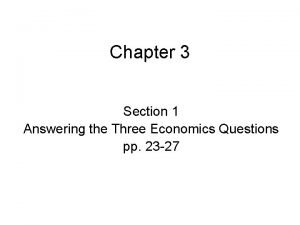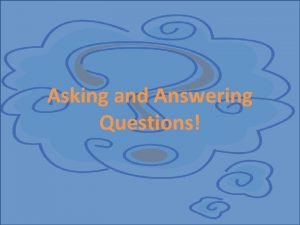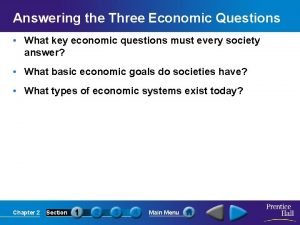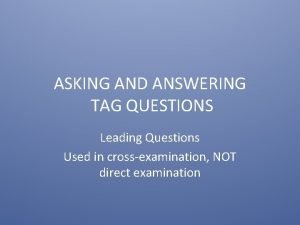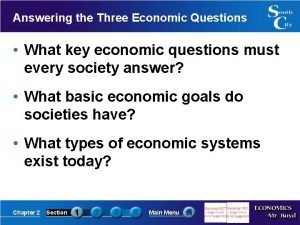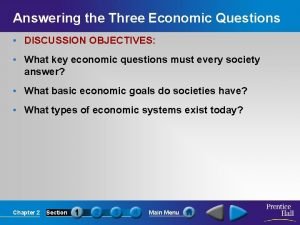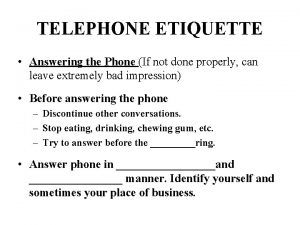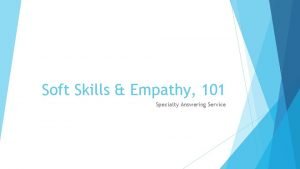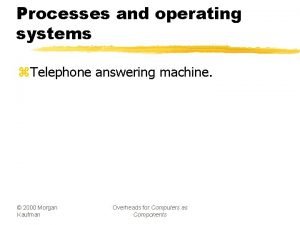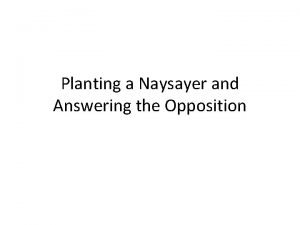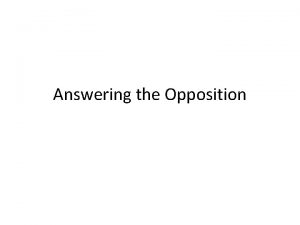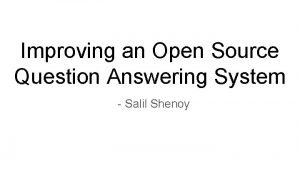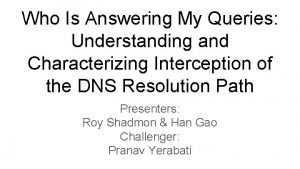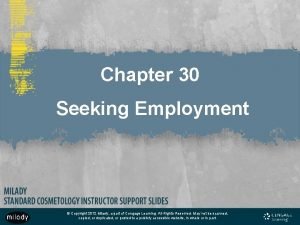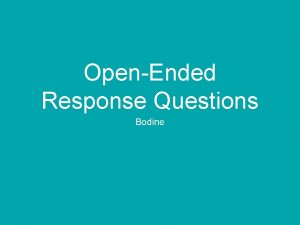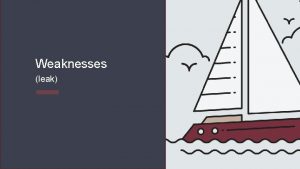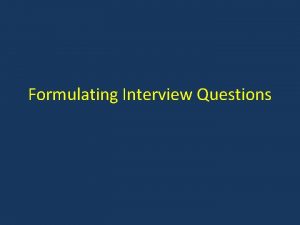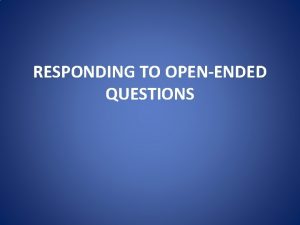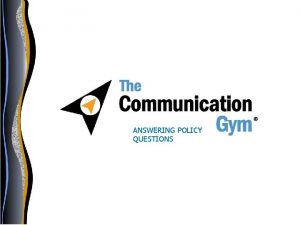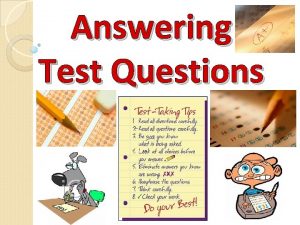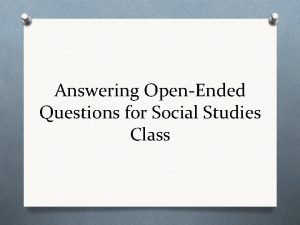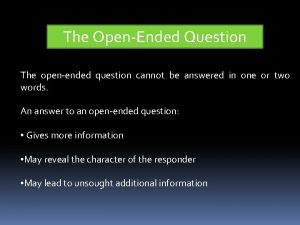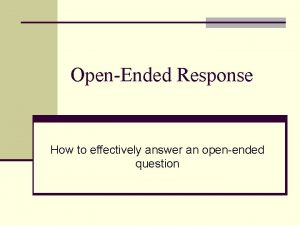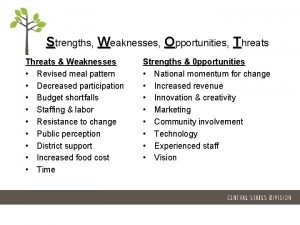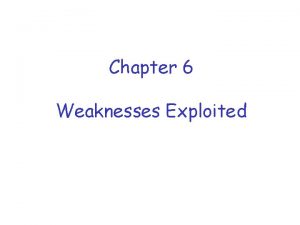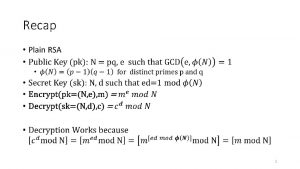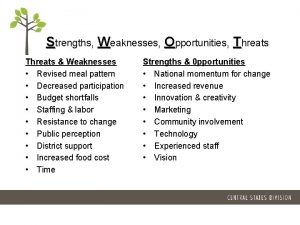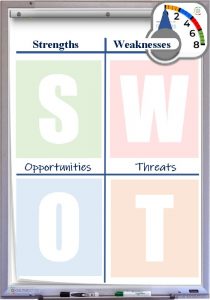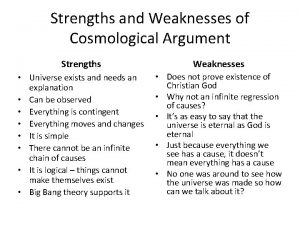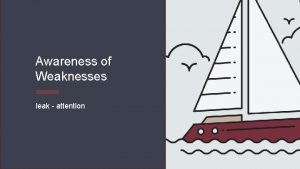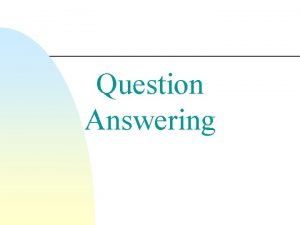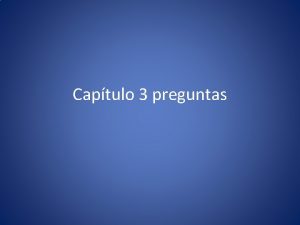Openended Questions Weaknesses in answering openended questions q



















- Slides: 19

Open-ended Questions Weaknesses in answering open-ended questions q Incomplete answer. q Do not understand the concepts tested q Not in context of the question. q Not specific enough. - too general (no scientific terms used) - too much unnecessary information

Open-ended Questions Tips q Read the question carefully. q Underline key words to highlight what is being q asked in the question. q Understand the topic and concept being tested q in the question. q Note the marks awarded to each question in order to know how much to write for the answer.

Open-ended Questions – WHAT = Give a noun: Object/ Action/Event – WHY = Give Reason/ Cause & Effect – HOW = Explain the Method / Process/ Steps in sequence – DESCRIBE – EXPLAIN – GIVE A REASON

Types of Questions in Science Exams

Identifying the Relationship q Rephrase the question to become your answer. Most of the required words are found in the question. q Show cause followed by the effect in the answer. q Use “comparing” words (eg. greater, bigger, longer, heavier, more, smaller etc)

• Eg. Pg 96 Q 10(a) • Qn: Predict how the depth of the dent would change with the height of drop. cause • Ans: The greater the height of drop, the greater is the depth of the dent. • effect

Generating • Give a reason why the set-up does not work. • Suggest a way to improve the set-up. • Draw inferences, predictions, conclusions & construct hypotheses • Devise a method to test hypothesis

• Eg. Pg 99 Q 11(b) & (c) • Qn: Give a reason why the set-up cannot be used to count more than 6 sheets of the paper. • Ans: The intensity of the light is not strong enough to pass through more than 6 sheets of paper. Reason • Qn: Describe one change that May Ling can make to the model if she wants to count up to 8 sheets of the same type of paper. • Ans: Put the torch nearer to the papers or the light sensor Suggest & Improve

• Pg 57 Q 27 (a) • Qn: Based on Devi’s results, which colour did most of the butterflies prefer? • Ans: Most of the butterflies prefer yellow. conclusion • Qn: Given a piece of black cloth and an identical tray with dry soil, how could he carry out an experiment to find out if organism Y prefers dark conditions? • Ans: Cover half the tray with the black cloth and put a number of organism Y in the middle of it. If most of the organism Y moved to the covered part of the tray, it shows that they prefer dark conditions. Test hypothesis

Communicating • Analyse flowcharts, tables & graphs carefully Y X Increasing trend When X increases, Y increases. Y X Decreasing trend When X increases, Y decreases. Y X Remains Constant When X increases, Y stays the same. • Draw diagrams clearly with proper labels • Questions on identifying relationships generating conclusions could be found here. &

• Pg 98 Q 10 (a) • Qn: State how the pulling force changes with the angle x. • Ans: When the angle increases, the pulling force required also increases. Reading from graph (increasing trend) • Pg 109 Qn 21(a) (table) • Qn: Based on the results of his experiment, what could William conclude about the effect of heating different Reading from metals? table • Ans: Different metals increased by different lengths after heating.

Experimental Set-up • Understand what a variable is. variable: anything that you can change in an experiment change only ONE variable, the one you are testing all other variables to be kept the same • Ensure a fair test is carried out. • State purpose & conclusion. • What is a Control Set-up? a set-up used to compare with the other groups you are testing to show that any changes that take place in the experiment is due to the variable tested

• Pg 44 Q 14(b) • Qn: Which two set-ups should be compared to show that the roots of the plant absorb water? Give a reason for your answer. • Ans: Set-up A and C. Other than set-up C which has the roots wrapped in plastic bag, the other variables for both the set-ups are kept the same. Change only ONE variable • Pg 108 Q 20 (b) • Qn: In her experiment, Jenny decided to keep the height of the wooden plank constant. How did this make her experiment a fair test? • Ans: A fair test is conducted when only one variable is changed. By maintaining the height of the wooden plank constant, she ensures that only the volume of water inside the bottle is changed. Ensure a fair test

State purpose • Pg 4 Qn 33(a) • Qn: What is the purpose of the experiment? • Ans: It is to find out how the amount of water given to a plant will affect its growth. • Qn: Serene’s teacher told her that instead of pouring oil into the beakers, she could prepare a control set-up which would help her accurately reflect the change in the amount of water is actually due to the balsam plants. In the space below, draw and label the control set-up. (1 m) • Ans: Control set-up 300 ml of water

Application to Daily Lives • Usually appears as the last part of a question • Relate the answer to the Science concept present in the previous part of the question

• Pg 109 Qn 21(b) • Qn: What would happen to the bridge on a very hot day if there were no gaps? Give a reason for your answer. • Ans: The bridge will bend / deform/distort if there are no gaps. On a very hot day, the metal will expand greatly and if there are no gaps, there is no room for expansion. Apply to daily life examples

Procedural • Give clear, crucial & orderly steps to carry out an experiment. • Remember to include steps at the end to show the kind of observations required to be made & evidence to be gathered. (Ask yourself “How can you tell …? )

• Pg 108 Qn 20 (a)(Given materials) • Qn: Describe how she should carry out her experiment. • Ans: • Jenny could use the measuring cylinder to measure different volumes of water to be filled in the plastic bottle. • She could use the stop watch to measure the time taken for the plastic bottle to roll down the ramp. • She could repeat the experiment using different volumes of water in the plastic bottle. How can you tell?

Usually we have C. E. R. questions… • • Choice Evidence Reasoning Make the choice wisely Provide evidence from the question Give a clear explanation to support your choice. r! e b • Identify the science concepts & m e m keywords for that topic. Re • Relate the concepts back to the question by making references, that is, DO NOT MERELY PROVIDE MOTHERHOOD STATEMENTS!
 Example of open-ended question
Example of open-ended question Openended questions
Openended questions Openended questions
Openended questions Present continuous for future
Present continuous for future Economics chapter 3 section 1 answer key
Economics chapter 3 section 1 answer key Asking questions in spanish
Asking questions in spanish Chapter 2 section 1 answering the three economic questions
Chapter 2 section 1 answering the three economic questions Answering tag questions
Answering tag questions Chapter 2 section 1 answering the three economic questions
Chapter 2 section 1 answering the three economic questions Answering the three economic questions section 1 quiz
Answering the three economic questions section 1 quiz Procedures before telephoning
Procedures before telephoning Telephone answering etiquette in business
Telephone answering etiquette in business Specialty answering service
Specialty answering service Answering
Answering Naysayer examples
Naysayer examples Planting a naysayer in your text
Planting a naysayer in your text Answering
Answering Answering
Answering Answering my queries
Answering my queries Chapter 30 seeking employment
Chapter 30 seeking employment


